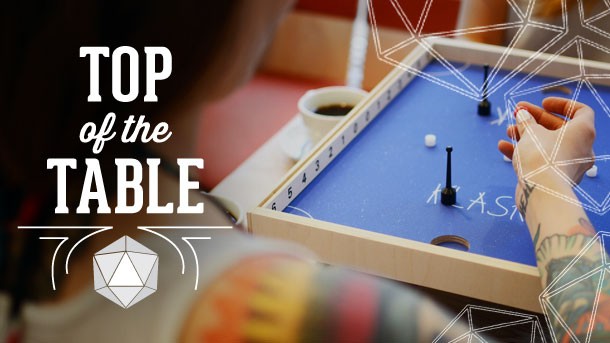Our extra-large special edition is here. Subscribe today and receive the 25% longer issue at no extra cost!
Top Of The Table – Klask

The ever-broadening scope and genres in tabletop gaming make for a fascinating study. Each year, designers and publishers push the boundaries of what we can expect out of the tabletop gaming hobby. We’ve seen new explorations of cooperative play through app-driven aid, legacy projects that change over multiple sessions, and highly tactile games built around component manipulation as much as strategy or dice-rolling. Klask immediately caught my attention for the way it differs from traditional tabletop games, but is nonetheless a great source of entertainment for parties, family game nights, or even for a couple looking for a more active, dexterity-based game to play together.
Klask is an odd-looking game. A raised wooden platform serves as the playspace, bounded on each side by a wooden barrier, and two opposing players each sit opposite one another with their hands positioned below the elevated board. A steering magnet is held beneath the platform, which connects to a striking magnet on the top side of the board that moves in response to each player’s under-the-table manipulations. A marble-like ball is placed onto the board, and each player’s striking magnet is able to knock the ball back and forth.
Rules and objectives are very simple. Your goal is to score points on your opponent in one of four ways. A hole on either side of the board acts as a goal; knock the ball into your opponent’s goal for the most obvious score. In addition, smaller white magnets mark the midfield, and if you’re not careful, you can get them attached to your striker; acquire two and you cede a point to your opponent. If frantic magnet movement ever makes you lose control of your striker, you also lose a point. Finally, if you accidentally drop your own striker into your own goal, (making a sound like Klask!), then yet again, you lose a point.
And that’s pretty much it. There’s no complicated dynamics to learn, so it’s easy for someone to sight in on this weird game where it lays out on a table, and grasp the concept in moments.
Gameplay rewards dexterity; the more you play, the more you start to get a sense of how quickly you can move your magnets without losing control. More often than not, early games see more scoring from players making mistakes and losing control, rather than through actual goals. In my experience, kids and adults can pick up the game with equal skill and enthusiasm. A full game plays out in 5-10 minutes, with lots of laughter (and perhaps cursing) along the way. The magnet movement dynamic is a fascinating twist on expectation, and demands you learn a new skill – without seeing your hand, it’s much trickier to know exactly how and where to move to best block or shoot the ball. Plus, there’s a vaguely magical quality about seeing the strikers slip and slide across the board, seemingly without any hand to guide them.
From a design perspective, there’s a lot to admire about Klask. The table is ingeniously constructed by designer and carpenter Mikkel Bertelsen. The table feels solid and well-proportioned, and appropriately sized for players of varying arm and hand sizes. The included components are utilitarian but solid – the biggest danger is that frantic movements do occasionally dislodge a magnet or ball that goes flying away, so a well-lit play space is advisable so you can find the wayward pieces. The white magnets in the middle of the playspace add just the necessary layer of complexity to make the gameplay intriguing, since they occasionally are knocked free from their center locations, creating mobile obstacles that must be avoided. Overall, the game is light on mechanics and rules, innovative in its construction, and frequently loud during play, both because of its magnetized objects and the shouting that a given game can often foster.
Klask won several awards in the Scandinavian countries of its origin, but the game has begun to see broader release in the United States in recent months. It taps a different type of excitement than most of the traditional tabletop games I cover here, but for gaming groups looking for a simple game about agility and sport-style one-on-one competition, it’s worth a look.
If you’re hoping for some other great tabletop suggestions, I’d encourage you to check out the growing Top of the Table hub by clicking on the banner below. Most recently, I took a look at some of the hottest games discussed at this year’s massive Gen Con event. As always, hit me up via email or Twitter if there are particular games or topics you’d like to see featured in an upcoming column.


Get the Game Informer Print Edition!
Explore your favorite games in premium print format, delivered to your door.
- 10 issues per year
- Only $4.80 per issue
- Full digital magazine archive access
- Since 1991









